April 5, 2015
Wild foods of the Sinai
 Where I grew up, we got most of the food we ate at a supermarket, walking the aisles and picking it off the shelves. When I came to the Sinai and began walking with the Bedouin my relationship with food – what I ate and how I got it – changed. We’d still buy food in town before leaving for the mountains. Out on the trail though, the Bedouin would always be scanning the ground for other stuff to add to the general supply. Whenever they saw edible plants, they’d have a trailside nibble. They might keep some for a later meal. Sometimes, they’d pick more, to take home. Except for a few wild blackberries I never really ate like that back home. In the Sinai though, watching the Bedouin, I had the privilege of learning what I could eat, how I could find it myself, where and when.
Where I grew up, we got most of the food we ate at a supermarket, walking the aisles and picking it off the shelves. When I came to the Sinai and began walking with the Bedouin my relationship with food – what I ate and how I got it – changed. We’d still buy food in town before leaving for the mountains. Out on the trail though, the Bedouin would always be scanning the ground for other stuff to add to the general supply. Whenever they saw edible plants, they’d have a trailside nibble. They might keep some for a later meal. Sometimes, they’d pick more, to take home. Except for a few wild blackberries I never really ate like that back home. In the Sinai though, watching the Bedouin, I had the privilege of learning what I could eat, how I could find it myself, where and when.
Eating wild food feels good. It’s liberating not to pick it off a shelf. Not to have to pay for it. It can be fun. It tastes a bit different too, which is new. More than that, it feels like a rediscovery. Foraging was key to human survival from early times, but we lost the knowledge needed to do it centuries ago in Europe, as we settled in towns. Discovering it again feels like reclaiming an old birthright.
The Sinai isn’t overgrown with food. Plant cover is patchy at best so you have to look carefully and take your opportunities. It’ll rarely be enough alone. But it’ll be a brilliant supplement to help you stave off the hunger pangs.
So here are my ten all-time favourite wild foods of the Sinai.
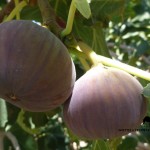 1. WILD FIGS There are two types of fig tree in the Sinai, but the fruit of one is much better than the other. It grows in the high mountains and, occasionally, in mid-altitudes of the desert, and ripens in July. For me, it’s the Sinai’s best wild treat. You can dry the figs if you’re out a long time too.
1. WILD FIGS There are two types of fig tree in the Sinai, but the fruit of one is much better than the other. It grows in the high mountains and, occasionally, in mid-altitudes of the desert, and ripens in July. For me, it’s the Sinai’s best wild treat. You can dry the figs if you’re out a long time too.
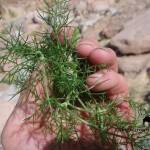 2. FENNEL A plant with stringy, feathery leaves and a strong aniseed flavour, this can be eaten as you find it. It won’t fill you up like fruit, but it’s a still a good trailside nibble that’ll stave off the hunger pangs. You usually get it in rocky mountain areas, mostly in the lower elevations.
2. FENNEL A plant with stringy, feathery leaves and a strong aniseed flavour, this can be eaten as you find it. It won’t fill you up like fruit, but it’s a still a good trailside nibble that’ll stave off the hunger pangs. You usually get it in rocky mountain areas, mostly in the lower elevations.
 3. DATES From the date palm, a high energy food, perfect for walking. You get them mostly in oases or lower lying wadis. Finding a bundle of dates is a blessing that’ll keep you going for days if you need it. Sometimes the dry and shrivelled dates on the floor are a sweeter, better snack.
3. DATES From the date palm, a high energy food, perfect for walking. You get them mostly in oases or lower lying wadis. Finding a bundle of dates is a blessing that’ll keep you going for days if you need it. Sometimes the dry and shrivelled dates on the floor are a sweeter, better snack.
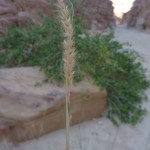 4. ATHMAAN A high rush-type plant with a feathery tip. Each stalk is a series of inter-connected parts; pull gently between these parts until one slides out of the other. The moist, fleshy stuff inisde is edible. It’s not much. But it wets your mouth and tastes OK. You usually get it in sandy areas.
4. ATHMAAN A high rush-type plant with a feathery tip. Each stalk is a series of inter-connected parts; pull gently between these parts until one slides out of the other. The moist, fleshy stuff inisde is edible. It’s not much. But it wets your mouth and tastes OK. You usually get it in sandy areas.
 5. HAWTHORN BERRIES These are the berries of the Sinai Hawthorn: they’re small and red, with a pip and not much flesh, so you have to grab a handful to make it worthwhile. They make a brilliant trail snack to nibble on though. The trees grow in rocky, shadowy gullies in the high mountains.
5. HAWTHORN BERRIES These are the berries of the Sinai Hawthorn: they’re small and red, with a pip and not much flesh, so you have to grab a handful to make it worthwhile. They make a brilliant trail snack to nibble on though. The trees grow in rocky, shadowy gullies in the high mountains.
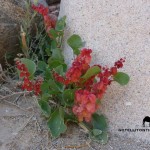 6. HOMATH One of my favourites. You can eat its leaves. They have a sharp, lemony taste and chomping into a clump in the desert sun is always refreshing. You can cut them and add them to salads too. You can also boil the leaves, then strain them and eat them in soups or even with sour goat’s milk.
6. HOMATH One of my favourites. You can eat its leaves. They have a sharp, lemony taste and chomping into a clump in the desert sun is always refreshing. You can cut them and add them to salads too. You can also boil the leaves, then strain them and eat them in soups or even with sour goat’s milk.
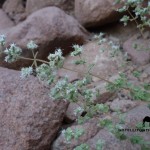 7. OREGANO A common mountain herb. This grows on rocky hillsides and the Bedouin use it a lot. It’s hot and spicy if you eat it raw and alone. It’s best sprinkled over cheese, salads, with olive oil etc. You can dry it too, then grind and mix it with pepper and salt as a flavouring for other food.
7. OREGANO A common mountain herb. This grows on rocky hillsides and the Bedouin use it a lot. It’s hot and spicy if you eat it raw and alone. It’s best sprinkled over cheese, salads, with olive oil etc. You can dry it too, then grind and mix it with pepper and salt as a flavouring for other food.
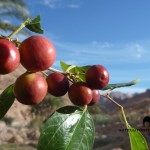 8. CHRIST’S THORN The Bedouin call this nabag. The fruit is a small, red berry, about the size of a marble. I don’t like it straight off the tree; like with dates, the dry fruits from the ground are better. They’re good, sugary nibbles, perfect for snacking. The tree grows mostly in mountain wadis.
8. CHRIST’S THORN The Bedouin call this nabag. The fruit is a small, red berry, about the size of a marble. I don’t like it straight off the tree; like with dates, the dry fruits from the ground are better. They’re good, sugary nibbles, perfect for snacking. The tree grows mostly in mountain wadis.
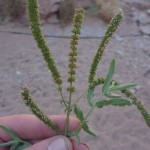 9. HORSEMINT The perfect addition to tea and therefore a Bedouin favourite. A few leaves in your glass gives tea the wild mountain touch. You can eat it too, but it’s strong. It grows near water – remember that, you might need water! – and you’ll often smell it on the breeze before you see it.
9. HORSEMINT The perfect addition to tea and therefore a Bedouin favourite. A few leaves in your glass gives tea the wild mountain touch. You can eat it too, but it’s strong. It grows near water – remember that, you might need water! – and you’ll often smell it on the breeze before you see it.
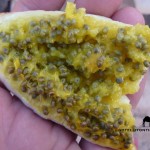 10. LASSAF Caper fruit and the biggest fruit on this list. Cut it in half and scrape the yellow flesh off, levering it over your bottom teeth. Gulp it down whole. Don’t munch it. The seeds are hot and will make you retch. Swallowing it whole, it’s sweet and delicious. It grows out of cliffs and rocky walls.
10. LASSAF Caper fruit and the biggest fruit on this list. Cut it in half and scrape the yellow flesh off, levering it over your bottom teeth. Gulp it down whole. Don’t munch it. The seeds are hot and will make you retch. Swallowing it whole, it’s sweet and delicious. It grows out of cliffs and rocky walls.
Here are the Latin/ English names for these plants. All the ones I know, anyway. I use the Bedouin names in the Sinai. If you know any of the missing names, please drop me a line so I can update this blog post.
| ENGLISH | BEDOUIN | LATIN |
| Wild fig | Teen Beree/ Hamaat | Ficus carica |
| Fennel | Shamaar | Foeniculum vulgare |
| Date palm | Balah/ Nakhl | Phoenix dactylifera |
| Sinai Hawthorn | Zahroor | Crataegus sinaica |
| ? | Athmaan | ? |
| ? | Homath | Rumex cyprius |
| Oregano | Zaatar | Origanum syriacum |
| Christ’s Thorn Jujube | Nabag | Ziziphus spina christi |
| Horsemint | Habag | Mentha longifolia |
| Caper | Lassaf | Capparis cartilaginea |
Remember, eating wild foods has potential risks. Some plants in this list have lookalikes and are easy to mistake with others. Some plants are poisonous too, so you need a Bedouin who really knows what they’re doing. Don’t use this list as a definitive field guide, because that’s not what it is. Please remember too, plants are key to the ecosystem and although nibbling one here or there is generally OK, you should be responsible with it. Don’t go harvesting wild plants for use at home. Just nibble them if you really need them.